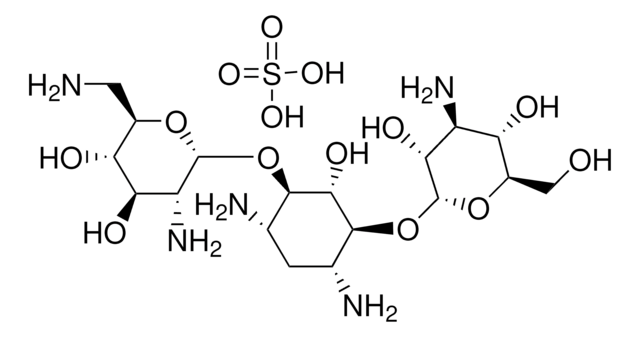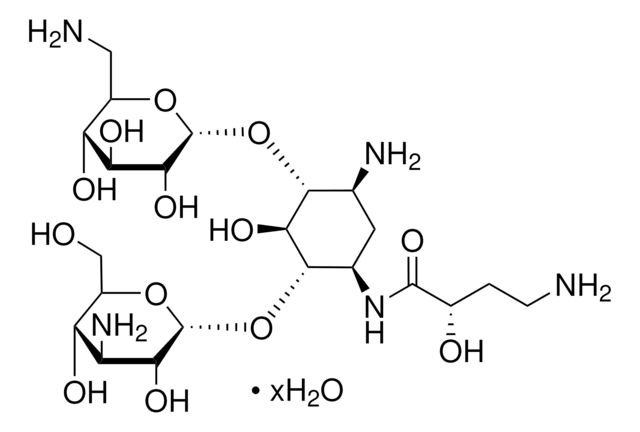K4000
Canamicina sulfate from Streptomyces kanamyceticus
Animal Component-free
Sinónimos:
Canamicina A, Canamicina sulfate salt
About This Item
Productos recomendados
origen biológico
Streptomyces kanamyceticus
Nivel de calidad
formulario
powder
potencia
≥750 μg per mg (dry basis)
color
white to off-white
solubilidad
H2O: 50 mg/mL, clear, colorless to faintly yellow
espectro de actividad antibiótica
Gram-negative bacteria
Gram-positive bacteria
mycobacteria
mycoplasma
Modo de acción
protein synthesis | interferes
cadena SMILES
OS(O)(=O)=O.NC[C@H]1O[C@H](O[C@@H]2[C@@H](N)C[C@@H](N)[C@H](O[C@H]3O[C@H](CO)[C@@H](O)[C@H](N)[C@H]3O)[C@H]2O)[C@H](O)[C@@H](O)[C@@H]1O
InChI
1S/C18H36N4O11.H2O4S/c19-2-6-10(25)12(27)13(28)18(30-6)33-16-5(21)1-4(20)15(14(16)29)32-17-11(26)8(22)9(24)7(3-23)31-17;1-5(2,3)4/h4-18,23-29H,1-3,19-22H2;(H2,1,2,3,4)/t4-,5+,6-,7-,8+,9-,10-,11-,12+,13-,14-,15+,16-,17-,18-;/m1./s1
Clave InChI
OOYGSFOGFJDDHP-KMCOLRRFSA-N
¿Está buscando productos similares? Visita Guía de comparación de productos
Descripción general
Aplicación
- in the research of bacterial antibiotic resistance
- in the research on the effect of different antibiotics on bud regeneration
Acciones bioquímicas o fisiológicas
Modo de resistencia: las enzimas modificadoras de los aminoglucósidos (como la acetiltransferasa, la fosfotransferasa y la nucleotidiltransferasa) pueden alterar este antibiótico y evitar su interacción con los ribosomas.
Espectro antimicrobiano: El sulfato de canamicina es eficaz contra las bacterias gramnegativas y grampositivas, y contra los micoplasmas.
Características y beneficios
Nota de preparación
Solutions are stable at 37°C for approximately 5 days. Aqueous stock solutions can be stored at 2-8°C for long term storage.
Almacenamiento y estabilidad
Otras notas
producto comparable
Palabra de señalización
Danger
Frases de peligro
Consejos de prudencia
Clasificaciones de peligro
Repr. 1B
Código de clase de almacenamiento
6.1C - Combustible acute toxic Cat.3 / toxic compounds or compounds which causing chronic effects
Clase de riesgo para el agua (WGK)
WGK 2
Equipo de protección personal
Eyeshields, Gloves, type N95 (US)
Elija entre una de las versiones más recientes:
¿Ya tiene este producto?
Encuentre la documentación para los productos que ha comprado recientemente en la Biblioteca de documentos.
Los clientes también vieron
Artículos
Extraction and quantitative analysis of aminoglycosides in porcine tissue, using molecular imprinted polymer solid phase extraction followed by LC-MS/MS.
Nuestro equipo de científicos tiene experiencia en todas las áreas de investigación: Ciencias de la vida, Ciencia de los materiales, Síntesis química, Cromatografía, Analítica y muchas otras.
Póngase en contacto con el Servicio técnico






